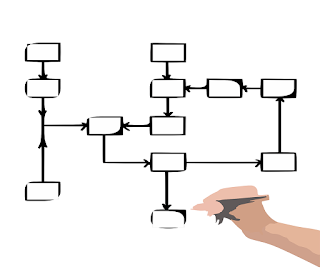I am honoured to have been asked by Clare to write a guest
post on flowchart sentence builders. Between Spanish lessons, I am also a Year
6 class teacher and SLE at Parkfield Primary School, Middleton.
Convenient timing brought me to the world of sentence
builders. There was a big push around knowledge organisers at my school and I
was tasked with sourcing or creating them for Spanish. Knowledge organisers –
or sentence builders as they are known in language circles – are by no means an
entirely new concept. Everyone has their own idea of what a knowledge organiser
should look like, and how it should be used. This is just me putting my hat
into the ring. Take it or leave it.
I studied the work of Dr.Gianfranco Conti and, with the
wonderful support of Dylan Viñales, head of Spanish at Garden International
School, I put what I had learnt into practice and produced my first set of
sentence builders! Proudly, I presented a sentence builder to each of my
classes. Here’s a Year 6 example that I created a year ago. Yikes!
The impact was…mixed.
Students really liked them but what I found disappointing
were the occasional errors that students continued to make even when the
pathways to a coherent sentence seemed so logical to me. In hindsight, it was
just too complex: there were too many possibilities with their own, grammatical
intricacies that presented a minefield for my students – cognitive overload
would strike!
Back to the drawing board I went.
With lockdown offering me the perfect opportunity to devote
some significant brainpower to the problem I was faced with, I diligently set
about to simplify and streamline my sentence builders. For a sentence builder
to facilitate real learning it had to be easy to follow, and without all the grammatical possibilities
crammed into one table. In the words of Señor Viñales, creating the ideal
sentence builder meant it
had to, “avoid the possibility of impossible combinations.”
At this point, I have to take time to mention
my wonderful and supportive husband, Mark. One evening, seeing how frustrated I
had become with a particular sentence builder focusing on prepositions, he offered
to help. Owing to the mathematical and scientific kind of person he is, he actually
understood the explanation ramble on
the grammatical possibilities and faux pas that the humble preposition would
inevitably create.
“Give me half an hour and I’ll see what I can
do!’ he said to me as he disappeared, determined to help his floundering
husband.
What he presented was to be the lightbulb
languages moment (see what I did there?) I had been trying to create. This was
a simplified, easy-to-follow-and-impossible-to-make-impossible-combinations
sentence builder. We named them ‘flowchart sentence builders’ owing to the
similarities they present with the traditional flow chart (apologies to any
purists out there). Any grammatical exceptions are studied in a separate
sentence builder. This way it’s possible to maintain the simplified view. By providing
the English equivalents, the possibility of cognitive overload is reduced further.
I raise awareness of any recurring grammatical patterns (plural, masculine or
feminine) by highlighting appropriate endings. Children will be able to follow
the arrows and come up with a possible combination, safe in the knowledge that it
will will be correct. I feel the space is freed up to focus on what’s important
– modelling a high quality, grammatically correct sentence.
Since this initial creation, Clare and I have chatted about
the possibilities and I have since spent this portion of the lockdown busily
devising flowchart sentence builders for each of my classes. I can’t wait to
use these with students when schools return to normal!



Love this! Could I ask what you use for a template? i.e Word? Publisher? Keen to get started! Many thanks!
ReplyDeleteJoe uses PowerPoint, I use Publisher. See my next post http://changing-phase.blogspot.com/2020/05/flowchart-sentence-builders-pt-2.html where I've put mine so far.
Delete